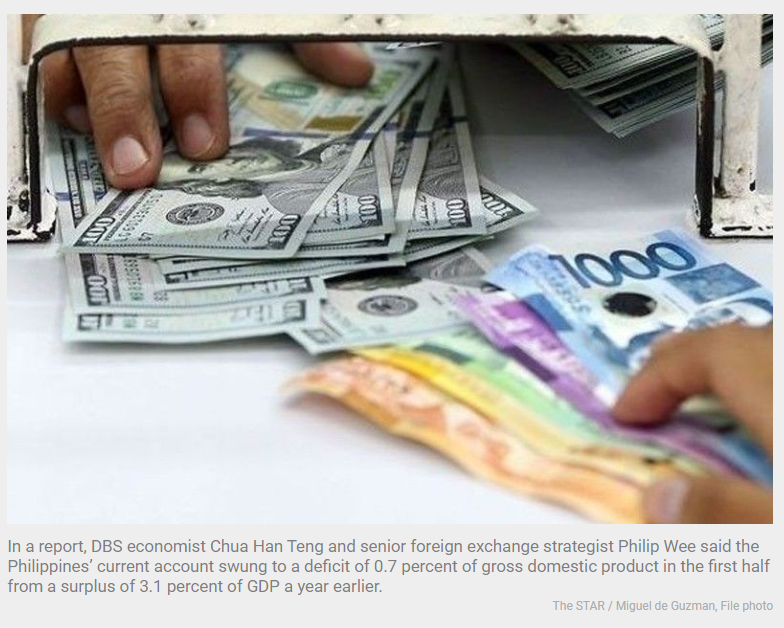Philippines: Peso seen depreciating to 52 to $1 – DBS
MANILA, Philippines — The peso may depreciate to P52 against the dollar in the first quarter of 2022 as the Philippines’ current account deficit is expected to swell anew due to rising imports following the gradual reopening of the global economy, according to Singapore’s DBS Bank Ltd.
In a report, DBS economist Chua Han Teng and senior foreign exchange strategist Philip Wee said the Philippines’ current account swung to a deficit of 0.7 percent of gross domestic product (GDP) in the first half from a surplus of 3.1 percent of GDP a year earlier.
“The Philippines’ current account is back to a deficit on rising goods imports as the economy recovers. The current account deficit will act as a headwind to the Philippine peso,” DBS said.
After peaking at a fresh four-year high of 47.7 to $1 early in June, DBS said the peso has emerged as the second worst performing currency in Southeast Asia, shedding 4.4 percent between June 7 and Sept. 20.
“We expect the peso to stay above 50 to $1 into 2022,” the bank said.
The investment bank sees the peso ending 2021 at 51.5 before further weakening to 52 to $1 by the end of the first quarter of 2022.
It expects the peso to recover and strengthen to 51.5 in the second quarter of next year and further to 51 to $1 in the third quarter and to 50.5 to $1 in the fourth quarter of 2022.
Externally, DBS said the dollar strengthened globally after the US Federal Reserve shifted to a hawkish tilt during the Federal Open Market Committee (FOMC) meeting in June.
After the Jackson Hole Symposium in August, the investment bank said the US Fed signaled its intention to taper asset purchases in late 2021 or early 2022.
The Bangko Sentral ng Pilipinas has slashed the projected current account surplus to $3.5 billion or 0.9 percent of GDP for this year.
For 2022, the Monetary Board expects a current account deficit of $1.4 billion or -0.3 percent of GDP instead of a surplus of $6.7 billion or 1.5 percent of GDP.
“We find that fluctuations in the Philippines’ current account have been largely driven by the ebb and flow of the goods trade deficit. The other balances such as services trade, primary and secondary income, meanwhile experience only minor swings relative to goods trade,” DBS said.
DBS also said the current account deficit of the Philippines this year is in line with the wider goods trade deficit arising from the stronger recovery in imports relative to exports.
Furthermore, DBS explained the Philippines has managed to accumulate ample foreign exchange buffer due to the strength of the peso in 2020.
The country’s gross international reserves stood at $108.05 billion in end-August, equivalent to 12.3 months’ worth of imports of goods and payment of services.
“We believe that the Philippines’ reserves are in a position of strength. They provide sizeable buffer for authorities to lean against depreciation, should the currency face weakening pressures over the coming months,” the investment bank said.
Source: https://www.philstar.com/business/2021/10/05/2131768/peso-seen-depreciating-52-1-dbs


 English
English




